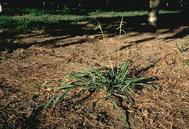
Apricot
 Survey Weeds—Late Fall
Survey Weeds—Late Fall
By surveying weeds in fall, you can identify summer species that escaped previous control attempts and determine which perennials are present. If herbicides were used, surveying identifies the need for changing to another herbicide. Fall monitoring will also identify any winter species that are emerging.
Ideally tree rows are weed free, whereas weeds growing in row middles may be beneficial in reducing erosion, soil compaction, water runoff, and sediment runoff to creeks and streams that ultimately impairs water quality. However, perennial weeds are problematic and should be kept from establishing in row middles.
How to survey your orchard
- Survey your orchard after the first rains of the fall when winter annuals have germinated.
- Look for winter annual weeds in tree rows to check the effectiveness of any preemergent herbicide applications.
- Pay particular attention to perennials; check for regrowth of perennials a few weeks after cultivation.
- Sketch a diagram of the orchard and mark areas where perennials are found.
- Keep records of your survey results for future management decisions (sample late-fall weed survey form—.
Survey information collected over a period of years tells you how weed populations may be changing and how effective your management operations have been over the long term. By knowing which species are present, you will be able to make appropriate decisions on cultural and chemical controls.
Important links
- Photos of winter annual weeds you may see
- Photos of perennial weeds you may see
- Late-fall weed survey form
- Integrated weed management
PDF: To display a PDF document, you may need to use a PDF reader.